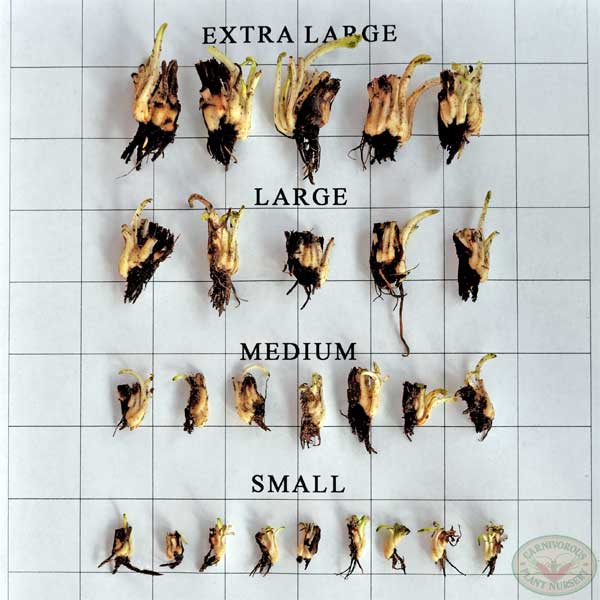
Sizes of Our Carnivorous Plants
We offer a variety of size choices because growers often want plants of different sizes and ages for different purposes. For some, smaller younger plants are more fit for the space or budget. Others want a natural look in their plantings with plants of various ages and sizes. Carnivorous Plants are typically small plants (except in the movies). Different genera and species can be dramatically different in size. A mature sundew or even a Venus Flytrap may seem like a pygmy compared to some juvenile pitcher plants. We reserve the right to upgrade or provide an equivalent portion of a different size. Time of year also affects size, as dormant plants are smaller than when they emerge in the growing season and winter flytraps grow smaller traps in winter, but their corms remain full size. Typically, sizes fit the following description:
Small Plants are typically in their juvenile stage. One to two years old, depending upon variety.
Medium Plants are typically beginning maturation and will flower next year. Two to three years old, depending upon variety.
Large Plants are typically fully mature and have been flowering for one or more years. Three years or older, depending upon variety.
We generally recommend buying medium or large plants which represent multiple years of extra growth vs. small sizes, but we offer a full range to accommodate everyone's growing interest and budget.
Sizes of Typical Carnivorous Plants
Venus Flytrap:
(sized by the length of the corm(bulb))
Medium: typically about 1/4+" across, with possible mature traps. 2-3+ years old. Suitable for a 3" pot.
Large: typically about 1/2+" across, with multiple mature traps. 3+ years old. Suitable for a 4" pot.
Extra Large: typically about 5/8+" across, with multiple mature traps. 4+ years old. Suitable for a 4-6" pot.
There can be differences as described for venus flytraps that are normally small, like Red Garnet, or normally large, like the King Henry or varieties with normal size traps like Typical or very large traps like B-52. Note that dormant or emerging plants will by nature have smaller traps.
Sarracenia and Darlingtonia
(sized by the rhizome thickness)
Medium: typically about 1/4+" thick, with possibly some mature tubes. 2-3+ years old. Suitable for a 3" pot.
Large: typically about 3/4" thick, with mature tubes. 4+ years old. Suitable for a 4+" pot.
There can be differences as described for pitcher plants that are normally small, like the Parrot Pitcher, or normally large, like the Leuco Titans. Traps may be trimmed especially in their dormant season.
Sundews
Medium: typically about 3/4+" across, with possibly some mature traps. 2+ years old. Suitable for a 3" pot.
Large: typically about 1+" across, with mature traps. 3+ years old. Suitable for a 4" pot.
There can be differences as described for sundews that are particularly small, like pygmy sundews, or normally large, like the Cape Sundews.
Butterworts
Medium: typically about 3/4+" across, with possibly mature leaves. 2+ years old. Suitable for a 3" pot.
Large: typically about 1+" across, with mature leaves. 3+ years old. Suitable for a 3-4" pot.
There can be differences as described for butterworts that are particularly small, like Pinguicula esseriana, or especially large, like P. gigantea.
Cephalotus
Medium: typically about 1+" across, with possibly some mature traps 1/4-3/8+". 2-3+ years old. Suitable for a 3" pot.
Large: typically about 2+" across, with multiple mature traps 3/4-1+". 5+ years old. Suitable for a 4" pot.
The Giant Cephalotus are typically 1.5-2x larger in dimensions.
Heliamphora
Medium: typically about 1-1.5+" tall, with possibly mature traps 1/4-1/2+". 2-3+ years old. Suitable for a 3" pot.
Large: typically about 2+" tall, with mature traps 1-2+". 3+ years old. Suitable for a 4" pot.
Larger species are typically 1-3x larger in dimensions.
Nepenthes
Medium: typically about 3" tall or wide, with juvenile or possibly mature traps. 2-3+ years old. Suitable for a 3+" pot.
Large: typically about 6+" tall or wide, with possibly multiple mature traps. 4+ years old. Suitable for a 6+" pot.
Larger species are typically 1-3x larger in dimensions. Some species, such as the lowlands forms, may not show mature traps in small and medium size. Note that traps may be trimmed or removed for shipping.
Bladderworts and Genlisea
Sprig: for aquatic bladderworts - typically a length about 3+" long, including several nodes and/or branchings. Enough to start a colony. Note that dormant plants are shipped as turions, that are smaller by nature.
Bog Orchids
Medium: young flowering plants, typically about 5+" tall. 2-3+ years old. Suitable for a 3+" pot.
Large: mature flowering plants, typically about 6+" tall. 3-4+ years old. Suitable for a 4+" pot.
There can be differences as described for bog orchids that are typically small, like Rose Pogonia, or typically larger, like Lady Slippers. Dormant plants are shipped as bulbs or bare rhizomes and are by nature smaller than the growing plant.
Seeds
Pck25: Pack of 25 seeds.
Pck50: Pack of 50 seeds.
Pck100: Pack of 100 seeds.
Soil
Medium: 2.5 quarts, 170 cubic inches, enough for about five 4" round pots. (measurements approximate)
Bulk Back: 8 quarts, 540 cubic inches, enough for about twenty 4" round pots.
